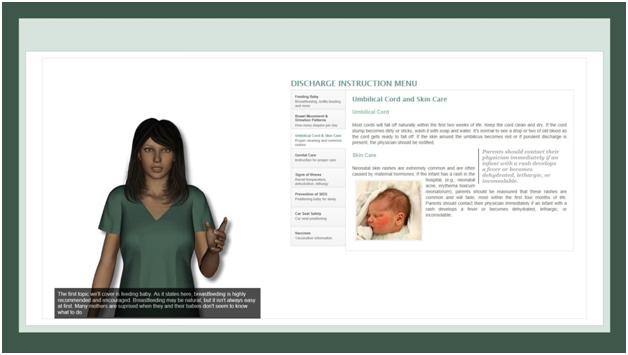Simulated RN™
Virtual Healthcare Agent

The Design
Now that we understand our users, it's time for brainstorming and iterative designing until we have the design we want to build and test.
Requirements
The systematic analysis of cross-functional requirements includes both short and long term targets. All interface requirements focus around the concept of expanding the communicative commonality (e.g., reducing barriers to communication) between the system and patient. To perform the tasks successfully, an individual must be enabled with functionality to perform each task satisfactorily. The requirements listed below are representative of the abilities that the system must support, including accommodations to enable individuals with disabilities to perform the essential functions.
Short Term Functional Requirements
In the short term, the preliminary interface shall autonomously—in parallel with hospital staff—facilitate the intended workflow of the teaching and instruction component of the discharge process. This requirement will increase educational time spent with the patient, while reducing time constraints on healthcare providers.
The interface shall communicate through natural speech. The system shall include simplified navigation that allows the users to interact without needing to ask for help. The system shall support tasks completed through touch-based user inputs. These requirements will improve hospital efficiency by improving communication, better patient understanding, while reducing processing time and rework.
The interface shall support an instructional framework that is modeled after the accepted post-partum teaching and instruction experience. The prototype system shall accommodate the multisensory modalities of users through use of audio, visual and kinesthetic touch. These multisensory functions shall accommodate various user learning styles (Johnson, Sandford, & Tyndall, 2003), including subject matter content supported by visual aids (Koonce, Giuse, & Storrow, 2011). These requirements will improve the acquisition of knowledge, patient comprehension and satisfaction.
Due to the concerns with literacy levels for some patients, and addressing the needs of the hearing-impaired, the interface shall combine audio/verbal narration with written subtitles to further enable user participation (Johnson, Sandford, & Tyndall, 2003). The dialogue content and readability, including visual illustrations must support the user’s ability to understand the content (Austin, Matlock, Dunn, Kesler, & Brown, 1995). Therefore, the interface shall also support multiple languages to further assist patients with various language needs (e.g., Spanish, Arabic). These requirements will further improve communication and accessibility.
Behavioral Requirements
The system shall provide virtual face-to-face consultation with patients in a manner that ‘feels’ instinctively natural (e.g., shall include high behavioral realism). The system shall elicit social reactions from the user through virtual social cues (e.g., conversation, nonverbal gestures).
Environmental Requirement
The interface hardware shall keep a low profile in the patient room in an unobtrusive manner.
Long Term Functional Requirements
Empirical investigation will be needed in the future to demonstrate the effectiveness of these proposed requirements in the preliminary design. In the long term, the interface shall provide information that supports cognitive learning and evaluation of user comprehension. Due to the various literacy levels of users, the system will assess and adjust its instructional framework to complement the user’s comprehension framework (e.g. reading level, utilization of visual elements such as video and animation). The system shall influence healthcare outcomes by lowering adverse events through effective instructional content. The system shall increase patient satisfaction with the interface allowing users to achieve a better understanding of their healthcare.
Design Space
Visual Character in the Design Space
In comparison of an animated character in the design space with the video recorded character, the animated character was preferred mainly because of the enduring advantages. The use of 3D animation in the design structure provides for more control and the ability to edit. In addition, research has revealed that when a user knows that a virtual character is a representation of a human being, and the agency high, social instincts take place allowing for social effects to occur (Putten, Kramer, Gratch, & Kang, 2010). The use of a high agency character should reduce the potential of a negative affect during user interactions.
Audio Character in the Design Space

Another major issue related to the use of human speech versus computer-generated speech. Face-to-face consultation remains one of the most instinctive methods of communicating and most often requires auditory speech (Qualls, Harris, & Rogers, 2002). Many of the same arguments that were previously outlined for the visual character can also be made for the audio character. It’s important to provide speech that a user can clearly understand, which may affect the user’s ability to receive information (e.g., ability to follow instructions, navigation, and comprehend material). Computerized speech can be difficult to support because the generated speech may not always pronounce words correctly and the synthetic speech articulation is often noticeable by users. Many speech engines provide limited options to directly correct the phonetic speech, or in some cases, the process requires an advanced understanding of the technology.
In regards to user perception, the principles of the Uncanny Valley effect would suggest the use of a computer-generated speech might actually aid in the user acceptance of a computer-generated visual character, since the visual and audio elements clearly correspond as being computerized. Results from previous research indicate that if a user’s expectation agrees with the simulated experience the user is less likely to generate a negative response (MacPherson, 2009; Brown, 2011). Therefore, the preference to use computer-generated speech is predicted more favorable in this design space.
Interface Navigation in the Design Space
The preference for computer hardware or a specific platform in the design space can affect the environmental space as well as the navigation structure. It is more customary for users to use a mouse and keyboard to interact with computer hardware, but in a patient room, these devices would require additional environmental space for storage and use. Touch-based technology is part of a growing trend in modern interface design. The touch-based technology is popular in mobile and tablet interfaces, which may provide some users with a degree of familiarity, but may not be intuitive to all users.
As part of the environmental requirement of the hospital, the computer platform had to keep a low profile in the patient room. In conclusion, the Dell Inspiron 2320 all-in-one touch screen computer was selected as the target device for this design. This computer was chosen because it offered a thin structure that could be wall, or cart mounted, so that in the hospital environment it would not occupy much space and could be deployed as needed. In addition, the Dell Inspiron 2320 includes a large display surface consisting of a 23-inch touch screen at a relatively low cost.
The Design
Virtual Agents
There is a significant body of research on the use of virtual characters in interface design. Designing systems that appear to resemble human beings (Anthropomorphic design) or human behaviors may provide a psychological advantage in interface design. Corresponding to the Threshold Model of Social Influence human beings initially only respond socially to other human beings (Blascovich, 2002; Blascovich et al., 2002). This supports the notion that virtual human characters of high agency represent an existing intrinsic mental model for social interaction. Therefore, once the temporal novelty of the situation vanishes, the user becomes accustomed to the interaction with the interface (Blascovich, 2002; Blascovich et al., 2002; Kiesler & Sproull, 1997). According to Putten et al., (2010) “When the factor agency is high, (e.g., when the user knows that the virtual character is a representation of a human being), then the factor behavioral realism does not have to be high in order for social verification to take place and for social effects to occur” (p. 1642). Furthermore, Putten et al, (2010), concluded on the basis of the empirical findings that agents and avatars with higher behavioral realism provide more social cues and therefore elicit more social response.
Proof of Concept
The use of virtual agents in healthcare is not new, over the past several years the Boston Medical Center in collaboration with Northeastern University have yielded promising results using an embodied conversational agent named Louise (Project RED). The Simulated RN design has been notably influenced by, and modeled after, many of the aspects in the Project RED design. For example, both interfaces use the natural format of face-to-face conversation model of interaction. The Simulated RN will accomplish this in a similar manner to the Project RED method using an animated character that talks to patients using computer-generated speech and synchronized body language behavior, such as hand gestures. In both designs, the patients communicate with the virtual agent though touch screen input responses (Bickmore, Gruber, & Picard, 2005; Bickmore, Pfeifer & Byron, 2010).
Usability evidence presented from the Project RED research suggests that patients with different levels of health literacy find the virtual agent acceptable and easy to use for automated health communication (Bickmore, Pfeifer & Byron, 2010). According to Bickmore & Jack (2009), “In a pilot study of the automated ‘virtual nurse’ system, 74% of hospital patients said they preferred receiving their discharge instructions from the virtual nurse, rather than their human doctors or nurses” (p. 7). In 2008, a randomized controlled trial comparing the affect of the Project RED process with usual care resulted in a 30 percent lower readmissions rate for patients that used the interface (Bickmore & Jack (2009). These findings suggest that the Simulated RN concept is an externally valid design approach in healthcare.
Nurse Character Design
The Simulated RN’s nurse character design will be generated from a 3D character model. The demographic characteristics of the virtual agent are designed to represent a 25-30 year old female, with brown hair and brown eyes. These features along with the agent’s skin, which is endowed with slightly darker than normal Caucasian tones, are designed to provide a blended racial appearance. As a result, the agent’s virtual racial or ethnic background is determined by the user’s perception, which could be Asian, African-America, Caucasian, Hispanic, Middle Eastern, or Native American. Previous research has shown that people apply ethnic stereotyping to virtual agents (Rossen, et al, 2008). Therefore, to reduce the potential of this affect, the agent is designed to be ethnically ubiquitous. Research conducted by Nass, Steuer, and Tauber (1994) observed a gender stereotype with virtual characters that related to the type of information being presented. Based on the primary user gender and subject matter, a female was selected to represent the nurse role. The Simulated RN’s computer generated speech is lip synchronized to the audio dialogue. The body language will consist of choreographed head turns, hand gestures, random shifts in posture or stance and eye movement with blinking. The overall presence of the virtual agent is designed to promote nonverbal communication, high agency through high behavioral realism, which has been shown to elicit natural social reactions (Blascovich, 2002; Blascovich et al., 2002). To further stimulate the nonverbal communication between the agent and user, the virtual agent is dressed in a modern nurse uniform to distinguish its role.
Future Technologies & Social Implications
Social Implications
The Simulated RN project has the potential to directly influence society, especially the lives of infants. A few examples of how low health literacy affects mothers of newborns include, more smoking around infants, increased likelihood of SIDS, mothers less likely to know how to use or read a thermometer, ability to recognize symptoms of infant illness, less likely to follow-up with appointments and less occurrence of breastfeeding (Weiss, 2003).
The social implications of the Simulated RN are mostly related to health outcomes. The Simulated RN is designed to improve the discharge process by providing an interactive learning environment that enriches user tasks through enhanced communication. Key social demographics that increase the potential of limited literacy include low income, unemployed, did not finish high school, minority ethnic groups, and recent immigration to United States and do not speak English, or English is a second language (Weiss, 2003). The social implication of low literacy skills has had an impact related to adverse events, increase in healthcare costs. If the interface can provide information that supports cognitive learning and user comprehension, it could someday influence healthcare outcomes by lowering adverse events.
